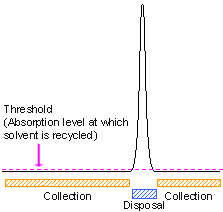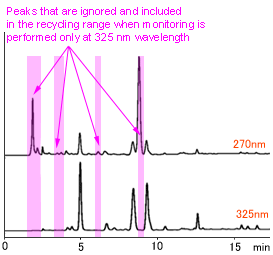Solvent Recycling
Outline
Another way to save solvent is to return part of the eluate that is discharged from the detector to the mobile phase bottle. This is referred to as "solvent recycling." If the optional Solvent Recycle Valve Kit for the UV-VIS Detector SPD-20A(V), SPD-10A(V)vp, or the LC-2010 series Integrated HPLC system is used, mobile phase that is discharged from the detector cell can be collected in the mobile phase bottle.


Principle of Operation
The Solvent Recycle Valve Kit collects solvent only when absorption does not exceed preset absorption level thresholds. (On the LC-2010, collection functions only for peaks that appear on the plus side; while, on the SPD-20A(V) or SPD-10A(V)vp, collection functions on both the plus and minus sides.) The amount of solvent that is recycled to the mobile phase bottles increases proportionately the fewer peaks there are, allowing the amount of consumed solvent to be reduced.

Precautions
Mobile phase gradually becomes contaminated since impurities in the sample, such as components (see figure on right) that were not detected at the wavelength used for detection, are also recycled to the mobile phase bottle. Contamination such as this increases noise on the baseline, and might damage the column. Since the mobile phase is more likely to be contaminated when there are a lot of impurities and components to be detected, samples that contain only specific components are suitable for solvent recycling. Reducing the amount of sample injection can also suppress contamination of the mobile phase.
When the same solvent as the mobile phase is injected during solvent recycling, the derivative peak of the solvent is sometimes recognized as a minus peak. This happens because recycled mobile phase is contaminated, which increases its absorption. If this kind of phenomenon occurs, immediately replace with new mobile phase.
Preferably, both the wavelength for detecting the target component and the lower wavelength side should be monitored simultaneously to see if unwanted peaks are being eluted during recycling. This can be confirmed easily on the UV-VIS Detector SPD-20A(V) or SPD-10A(V)vp, or the LC-2010 series integrated HPLC system, which are capable of 2-wavelength simultaneous measurement*.
* In dual wavelength simultaneous measurement, solvent is recycled according to the thresholds based on the chromatogram at the wavelength set to channel Ch1. If a wavelength (210 to 220 nm) shorter than the detection wavelength at which data is sampled is set to Ch1, safe collection is ensured without impurities being recycled. During recycling, the SV indicator on the detector unit lights up.
Restrictions
As can be seen in the flow path in the drawing above, solvent recycling is effective only for isocratic analysis; it cannot be used on gradient analysis.


